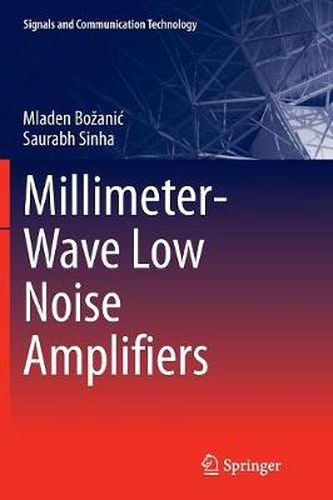Readings Newsletter
Become a Readings Member to make your shopping experience even easier.
Sign in or sign up for free!
You’re not far away from qualifying for FREE standard shipping within Australia
You’ve qualified for FREE standard shipping within Australia
The cart is loading…






This title is printed to order. This book may have been self-published. If so, we cannot guarantee the quality of the content. In the main most books will have gone through the editing process however some may not. We therefore suggest that you be aware of this before ordering this book. If in doubt check either the author or publisher’s details as we are unable to accept any returns unless they are faulty. Please contact us if you have any questions.
This book is the first standalone book that combines research into low-noise amplifiers (LNAs) with research into millimeter-wave circuits. In compiling this book, the authors have set two research objectives. The first is to bring together the research context behind millimeter-wave circuit operation and the theory of low-noise amplification. The second is to present new research in this multi-disciplinary field by dividing the common LNA configurations and typical specifications into subsystems, which are then optimized separately to suggest improvements in the current state-of-the-art designs. To achieve the second research objective, the state-of-the-art LNA configurations are discussed and the weaknesses of state-of the art configurations are considered, thus identifying research gaps. Such research gaps, among others, point towards optimization - at a systems and microelectronics level. Optimization topics include the influence of short wavelength, layout and crosstalk on LNA performance. Advanced fabrication technologies used to decrease the parasitics of passive and active devices are also explored, together with packaging technologies such as silicon-on-chip and silicon-on-package, which are proposed as alternatives to traditional IC implementation. This research outcome builds through innovation. Innovative ideas for LNA construction are explored, and alternative design methodologies are deployed, including LNA/antenna co-design or utilization of the electronic design automation in the research flow. The book also offers the authors’ proposal for streamlined automated LNA design flow, which focuses on LNA as a collection of highly optimized subsystems.
$9.00 standard shipping within Australia
FREE standard shipping within Australia for orders over $100.00
Express & International shipping calculated at checkout
This title is printed to order. This book may have been self-published. If so, we cannot guarantee the quality of the content. In the main most books will have gone through the editing process however some may not. We therefore suggest that you be aware of this before ordering this book. If in doubt check either the author or publisher’s details as we are unable to accept any returns unless they are faulty. Please contact us if you have any questions.
This book is the first standalone book that combines research into low-noise amplifiers (LNAs) with research into millimeter-wave circuits. In compiling this book, the authors have set two research objectives. The first is to bring together the research context behind millimeter-wave circuit operation and the theory of low-noise amplification. The second is to present new research in this multi-disciplinary field by dividing the common LNA configurations and typical specifications into subsystems, which are then optimized separately to suggest improvements in the current state-of-the-art designs. To achieve the second research objective, the state-of-the-art LNA configurations are discussed and the weaknesses of state-of the art configurations are considered, thus identifying research gaps. Such research gaps, among others, point towards optimization - at a systems and microelectronics level. Optimization topics include the influence of short wavelength, layout and crosstalk on LNA performance. Advanced fabrication technologies used to decrease the parasitics of passive and active devices are also explored, together with packaging technologies such as silicon-on-chip and silicon-on-package, which are proposed as alternatives to traditional IC implementation. This research outcome builds through innovation. Innovative ideas for LNA construction are explored, and alternative design methodologies are deployed, including LNA/antenna co-design or utilization of the electronic design automation in the research flow. The book also offers the authors’ proposal for streamlined automated LNA design flow, which focuses on LNA as a collection of highly optimized subsystems.